The Warhammer Community team dropped a large helping of information on Unit Coherency today, with new info on their streams and on Warhammer-Community. While we don’t publish all of these updates as posts, we transcribe them to use when we do our weekly round-up of rules. However they’re very popular and some news is so big that we don’t want to wait for the weekend to talk about it. Today is one of those days.
Games Workshop dispensed another unit of Treats today, in the form of a stream about 9th edition. The big game mechanic change was to unit coherency, but they also threw in a couple of datasheets for us. Oh yeah, and games are 5 turns now:
…over the standard* new edition game length of 5 battle rounds…
UPDATE: Immediately after writing this, but before publishing it, Warhammer Community dropped a post that forced us to expand this, which means more work for us and more Takes for you, which is what passes for a win-win here.
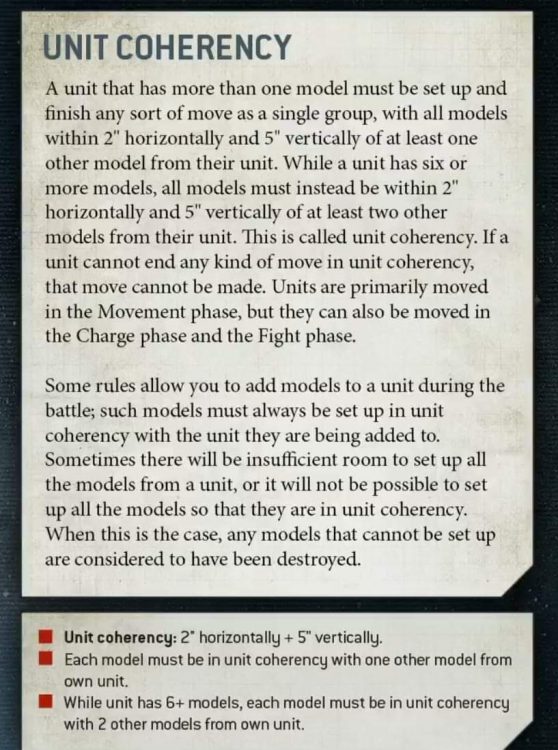
The basic rule that covers 90% of cases is unchanged – 2 inches between models has been standard for a long time – which means this should be easy enough to adapt to, but you get 5 inches of vertical coherence now. This seems designed to mesh with the new rules for terrain that we saw last week, allowing for models to be placed on top of 5 inch battlements, which also fits with the new generation of terrain kits introduced during 8th. We love this because it gives us a reason to bust out the old 5″ Large Blast template to use as a gauge. Unfortunately the starter kit terrain in Moon Base Klaisus doesn’t take full advantage of the new ruling, but we still recommend it as the ideal starting point for new players.
The change to require coherency with 2 other models was ostensibly designed to prevent conga-lining, but as Hammer of Math author Kevin immediately pointed out, all it really means is that each end of the conga line has to have two models on it instead of one. That isn’t nothing, and it does force your unit to look like a clipart version of a big tasty dog bone, which is fun. Being out of coherency isn’t something to take lightly, either:
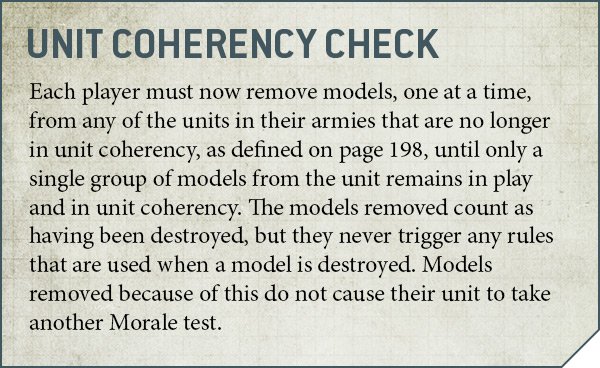
That’s right, in a validation of the fear that grips every dog-owner when their pet wanders off at the park, you don’t get to just hang around and move into coherency whenever you get around to it, your models straight up die. Turning back to our conga-line example, this would roll up the line and result in the entire unit disappearing as soon as the first model on the end is removed. That is, if you’re forced to remove the first model as a casualty, then the second is no longer in range of two, so they disappear during the coherency check. But that means the next model is no longer in range of two, so you remove that one, which means the third model… and so on down the line until you’re under 6 models in the unit and the rule no longer applies. We’re expecting either an FAQ or to have to write a Ruleshammer about this one just to really drive the point home, because that is hilariously punishing.
We also got some details on Activities, fun things your units can do with their friends:
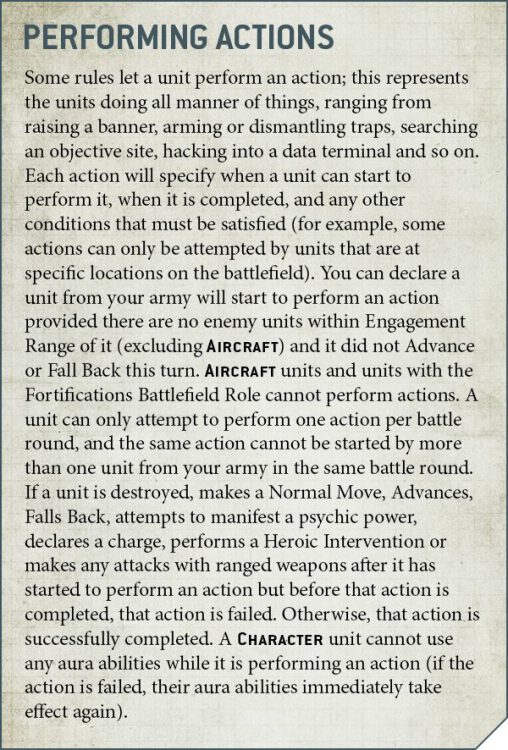
Pretty big change, this. If you’re familiar with any video game that involves capturing points, or the ITC 2020 mission pack and their “Saboteurs” secondary objective, this is a new take on that. Essentially, a unit takes a break from war, to accomplish some other action that gets you VPs. There’s a lot to digest here, and they’ve only given us one example of what an Activity is, which we’ll cover in a second, but here’s to hoping that “drifting go karts around Moon Base Klaisus” is on the list. If nothing else, it’s novel to add a fourth mechanic to the usual list of “move, shoot, punch” actions that a unit can take. Particularly rough chuckle here that it turns off auras, adding a note of tactical choice/desperation to having your Chapter Master do their own dirty work. We cover an important change to Aura abilities below, that we have to assume was absolutely made with this mechanic in mind.
The one Activity we know anything about, Raise The Banners High, is so 40k it hurts.
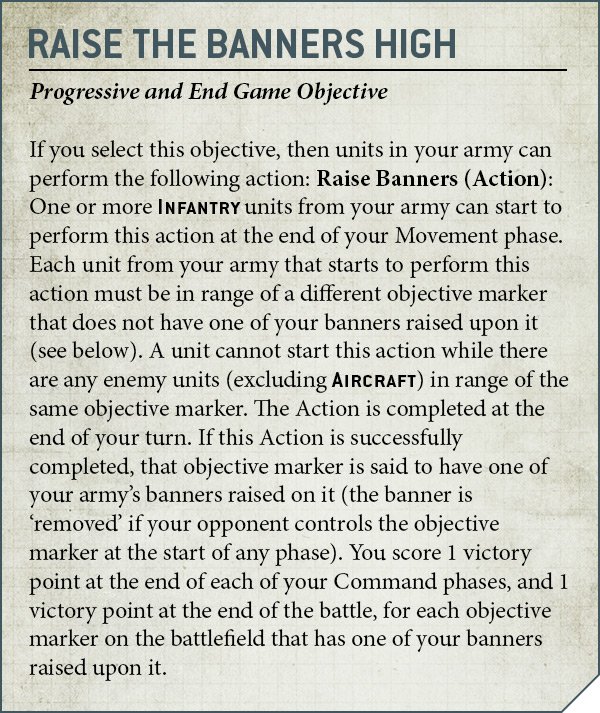
Notably, being buzzed by jets doesn’t impact your ability to do this Activity, it just makes you look cooler while doing it. It also functions as both a progressive and endgame objective, and adds a real “capture ground” feel that traditional objective-grabbing never really had. The ability to give up one turn of shooting to just put an objective on auto-pilot and passively generate VPs is great, but not half as great as the potential for incredibly cool objective markers with little flags on them.
It’s also pretty cool that the text here for “one or more infantry units from your army can start to perform this action” contradicts the “the same action cannot be started by more than one unit” text in the general Activities rule. That’s probably fine.
Whew. As if all of that weren’t enough, we also got the utterly terrifying datasheet for Primaris Eradicators, the melta-toting Gravis models from Indomitus:
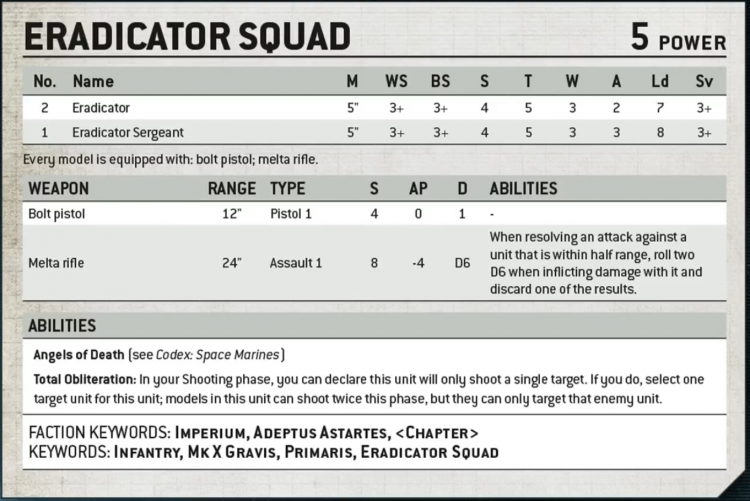
That’s a decent enough statline in a vacuum, and we’re always happy to see more Gravis units, but Total Obliteration is what makes them properly spicy – shooting twice for the relatively minor inconvenience of not splitting fire is borderline unfair. At 5PL, it costs all of 2 CP to hold two of them in Strategic Reserves, and the 24″ range on the Melta Rifle (without even having to dip into being a Heavy weapon) puts you in double-damage-dice-rolling range when you do so. Spending 1 CP and 5 PL – or probably around a hundred points at current exchange rates – to throw 6 double-damage melta shots (12 if you double-dip and can find someone to split a second Indomitus set with) at anything within a foot and a half of the table edge is pretty cool and virtually guarantees that they make their points back. There’s even a relatively minor buff buried in the change to the melta rule. It’s no longer “discard the lowest” result, it’s “discard one”. Granted, there aren’t a lot of situations where you wouldn’t yeet the lower of the two, but a) the flexibility is nice, and b) Quantum Shielding.
Necrons had rules for one of their new models previewed as well, the Cryptothralls, some kind of bitcoin-mining servitor with what has to be my favorite wargear list I have ever seen:
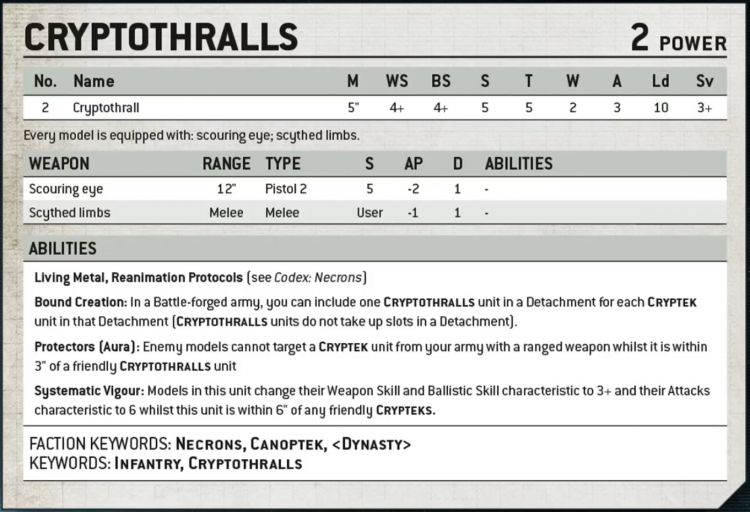
Equipped with: eyes, limbs. Same, little buddy. Incredibly same.
The ‘thralls have their own attacks, which actually aren’t even bad, but their Protectors aura (and thank god that GW is explicitly tagging aura powers now, with the proliferation of abilities [edit: or Activities, apparently] that turn them off, the clarity is appreciated) is an upgrade to the character targeting rules, making friendly nearby Crypteks straight up untargetable, which instantly makes them worth using. What’s 2PL (probably around 40 points) compared to avoiding every argument about character targeting and carefully managing model placement.
Getting servitor-style BS/WS improvements from Crypteks (incidentally, not considered an Aura) is a nice bonus, but really I wouldn’t expect these guys to ever get to use their BS or WS – dealing 4 T5 3+ wounds to remove the unit is so surmountable an obstacle that they’re probably just ablative wounds for your Cryptek and die before you get within their 12″ eyeball/pistol range. They also don’t take up an FoC slot, which is unambiguously a good thing in 9th – in 8th there was a case to be made that taking up a slot with a cheap unit like this would have been better than getting them for free, but the change to make detachments a CP cost instead of a CP benefit resolves that.
That’s it for today. Check back next time, when hopefully we have more Moon Base Klaisus content, and drop us a line at contact@goonhammer.com or in the comments to explain all the rules I inevitably got wrong.


